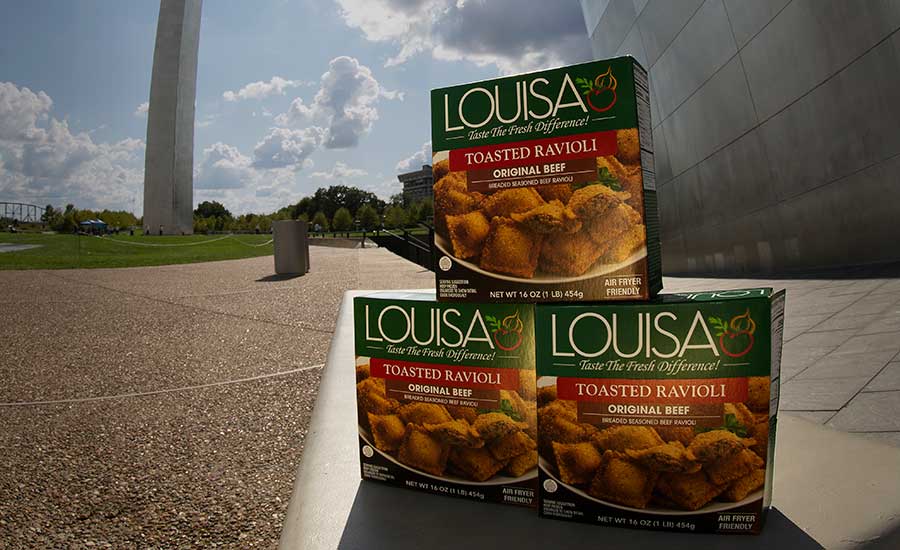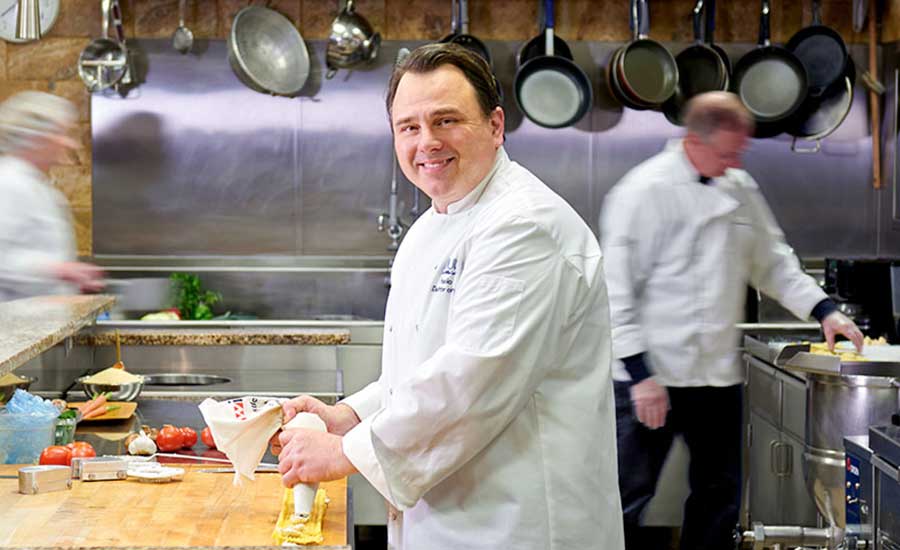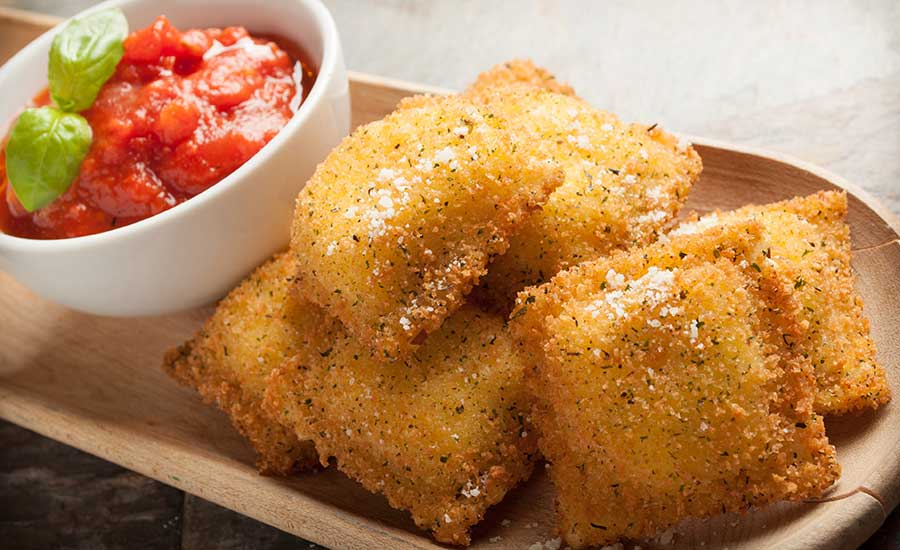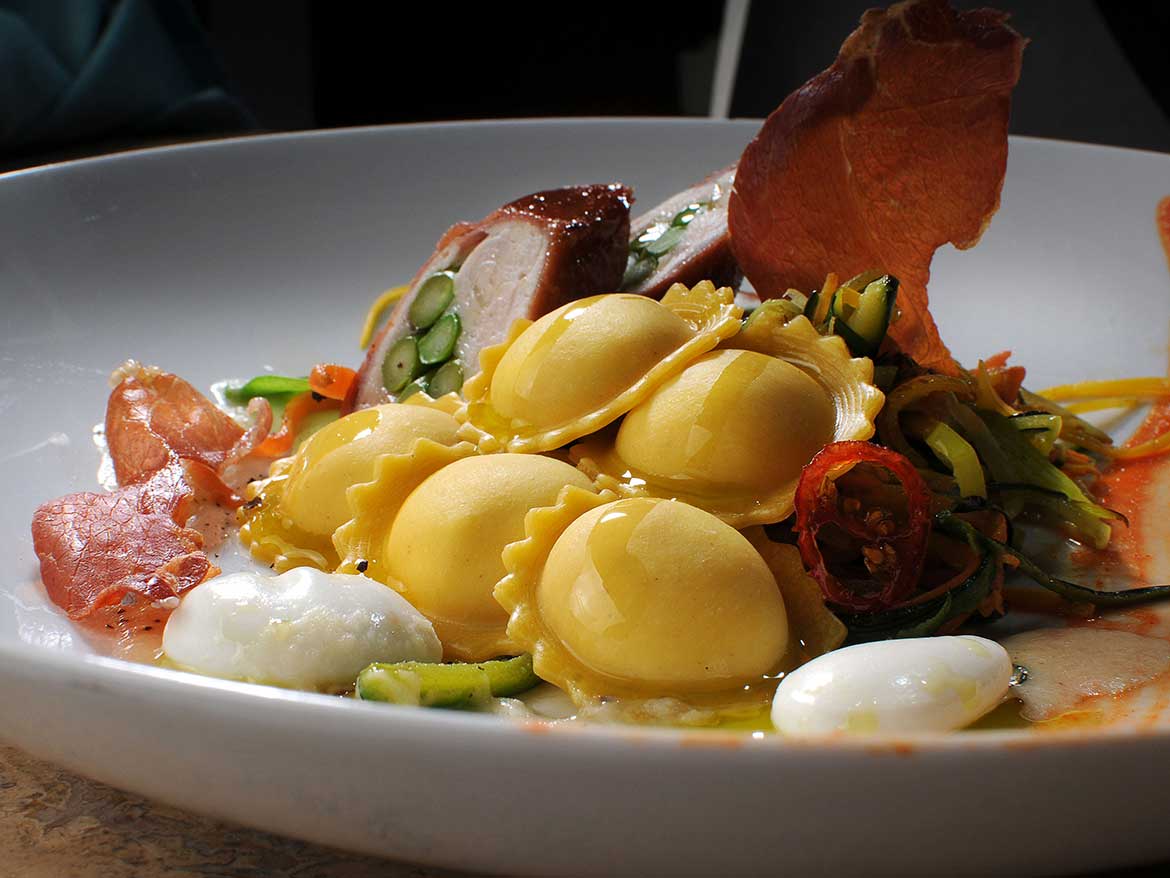St. Louis-based Louisa Foods—our 2021 Frozen Foods Processor of the Year—can trace its roots back almost 60 years, not to a food processing plant, but a single family-owned restaurant in the Gateway City.
“Louisa Foods was founded by my uncle, John Baldetti, and named the company ‘Louisa’ after my grandmother and his mother, Luisa Baldetti,” says Tom Baldetti, owner, Louisa Foods. “Luisa and her husband, Ferdinando, were immigrants from Italy. Like many other food manufacturers, we are a spinoff from a restaurant, owned by my grandfather Ferdinando. So, our first customer was our own restaurant. We started in 1964, and later, we provided primarily meat-filled ravioli to other restaurants in the area.”
One of those ravioli varieties soon became the company’s citywide calling card. “We started breading ravioli to be sold as ‘toasted ravioli’ in response to a request from our customers. It became our claim to fame,” Baldetti says.
The company continued to grow from there, and in the 1970s, Louisa started selling their products to regional grocery stores. Then, in the 1980s and 1990s, Louisa Foods expanded sales to restaurant chains. Today, the company employs 260 people, while 50% of their business comes from foodservice, and the other 50% is comprised of retail and industrial clients.
“We’ve made a lot of headway in making toasted ravioli a more known food on a national level, rather than just on a regional level,” says Baldetti. “We hope to use our toasted ravioli as a doorway to introduce the rest of our products nationwide.”
Indeed, while toasted ravioli can be found all over St. Louis today—even at concession stands for Cardinals baseball games—its growing popularity beyond the Midwest acts as a gateway through which the rest of Louisa’s frozen lineup can follow, helped by a recent (2019) distribution partnership with DOT Foods.
In addition to five different toasted ravioli flavors (beef, beef and cheese, four cheese, sausage and cheese, and buffalo style), Louisa makes multiple varieties of untoasted ravioli, tortellini, and cannelloni, along with newer frozen appetizers like mini manicotti, lasagna rolls, and toasted mac and cheese bites, among other products. These foods are sold in retail freezercases at Kroger, Walmart, Schnucks, Dierbergs, Jewel, Winn Dixie and others stores in the lower 48 states.
“The pandemic had huge repercussions for our business. As restaurants began to struggle, our foodservice business took a hit. However, as the number of home cooks grew during the pandemic, Louisa Foods’ retail business dramatically increased. The fact that the company maintained diversity with both its foodservice and retail options means we were able to successfully pivot and respond appropriately to the fluctuating situation,” says John Russell, Louisa Foods’ CFO. (Louisa Foods declined to disclose sales statistics for this story.)
The recent move toward an increased national retail presence has also come with a learning curve, particularly in scaling up quickly to accommodate demand for new hit products, like Louisa’s mac and cheese bites.
“We try to stay focused on the manufacturing side to define what our capabilities really are. The challenge of manufacturing is knowing how to scale up a new product. As ingredient availability, labor shortages, and other problems continue to plague the industry, Louisa Foods has had to work and collaborate with our partners by cross-utilizing ingredients and SKUs,” explains Baldetti.

R&D and Production Facilities
One of Louisa’s taglines is “Where Pasta is Always in Progress”. That’s especially true for Louisa’s in-house culinary team, which constantly develops and tests new filled pastas and frozen appetizers in their research kitchen—located at the company’s headquarters in suburban Jennings, Missouri, about eight miles north of downtown St. Louis.
“We’re bold enough to experiment with alternative flavor profiles in our retail and foodservice divisions. Items such as Stuffed Nachos and Fusion Bites speak to our willingness to think outside the Italian food box,” Baldetti says. “On top of that is the wide range of our products. Entrees such as Wild Caught Lobster Ravioli intermingle on our production lines with Jalapeno Mac and Cheese Bites, for example.”
Speaking of production lines, Louisa has four of them inside their 70,000-square-foot plant, also located at the company’s Jennings headquarters. Those lines produce between 30 and 40 million pounds of product per year.
As noted earlier, new hit flavors are necessitating the need to scale up production quickly when needed, so Louisa is currently planning to expand the facility for the fourth time since it opened in the 1960s. The company has made three major additions to the building over its lifespan, most recently in 2012. The current planned expansion would be the largest to date.
“Most of our critical forming equipment comes from Italy. Our basic cooling, mixing, freezing, and packaging equipment is made in the U.S.,” says Pete Baldetti, plant operations manager at Louisa Foods. “There are a fair amount of electronics involved, and a fair amount of equipment that was custom made for us. This is challenging because we are not large enough to demand a lot of customization from some suppliers. We have to do our own modifications.

“One notable feature of our production facility,” he continues, “is our modular approach to the space. Many components of our production lines are on casters to allow for easy adjustment to the lines as needed. Each night, the facility is completely turned over by removing and adding equipment to prepare for the next day’s production needs. In this way, we’ve been able to expand our capability of the limited space we have, which of course leads to the needed, aforementioned, expansion.”
Louisa’s production facility is audited annually, and has three HACCP programs that are SQF Level 2 Certified. The plant is also USDA inspected, SMETA audited, and the company is currently exploring PLC as a management tool to help production lines run more efficiently.
“In the past year, we have increased all of our training protocols,” notes Pete Baldetti. Additionally, we’ve added another layer of management in many areas of the plant. Our focus is on getting better results through training and accountability. We would also like to add more metal detection in our ingredient preparation process, instead of just at the end of the lines. For some products, we utilize x-ray, and internally, we have an in-house microbial testing facility, and send items out for third-party testing when needed.”
Processing and Packaging
The journey for a pasta product at Louisa—like their traditional meat-filled ravioli, for example—starts with the delivery of locally sourced fresh vegetables to the plant, which are cleaned and dried in a vegetable-processing area. Beef for the filling is ground in Louisa’s meat processing room, then seasoning is added to the beef in their spice room.
Those ingredients that make up the ravioli filling are brought together in a kettle or oven for cooking. Afterwards, the hot ingredients are delivered to a mixing area, where they’re blended with freshly grated cheese from Louisa’s cheese-grating room. The finished mixture is then sent to a ravioli-forming machine.
On the pasta side, the dough is created by adding water and eggs to a mixer that has flour metered in from a silo. That dough is taken to a ravioli-forming machine, where the filling and dough are merged into individual ravioli. The formed ravioli are then conveyed through cooking and freezing equipment, and packaged by vertical form-fill-seal equipment, and run through a metal detector.
The finished, packaged ravioli is stored onsite until they pass microbial testing. After that, the products are shipped to customers or to a local storage freezer by third parties (like DOT Foods) since Louisa doesn’t have its own fleet of trucks. Many local clients pick up the food directly from Louisa’s facility.
“We make everything from scratch. The sauce is made here, the vegetables are chopped and cooked here, and the meat is seasoned and prepared here. We make sure to prepare our products properly, using the old methods to ensure the quality of our offerings. Obviously, we are always looking for ways to vertically integrate our operations,” says Tom Baldetti.
With increased attention now focused on the retail side of Louisa’s sales, the company’s packaging has been updated for a sleeker, more modern look, along with addressing consumer trends like clean labels and air-fryer instructions on boxes. The result is an easy-to-use product geared toward convenience for home cooks. “Life has not gotten any easier, so providing a quick, quality solution for dinner is one less thing for our customers to worry about,” says Larry Bush, sales director, Louisa Foods.
As for Louisa’s recognition as our 2021 Frozen Foods Processor of the Year, Tom Baldetti concludes, “It validates all the hard work our team has put forth to make our company stand out. We work very hard to bring freshness to prepared foods, and I think this award indicates we have expanded beyond being a local or regional manufacturer.”






